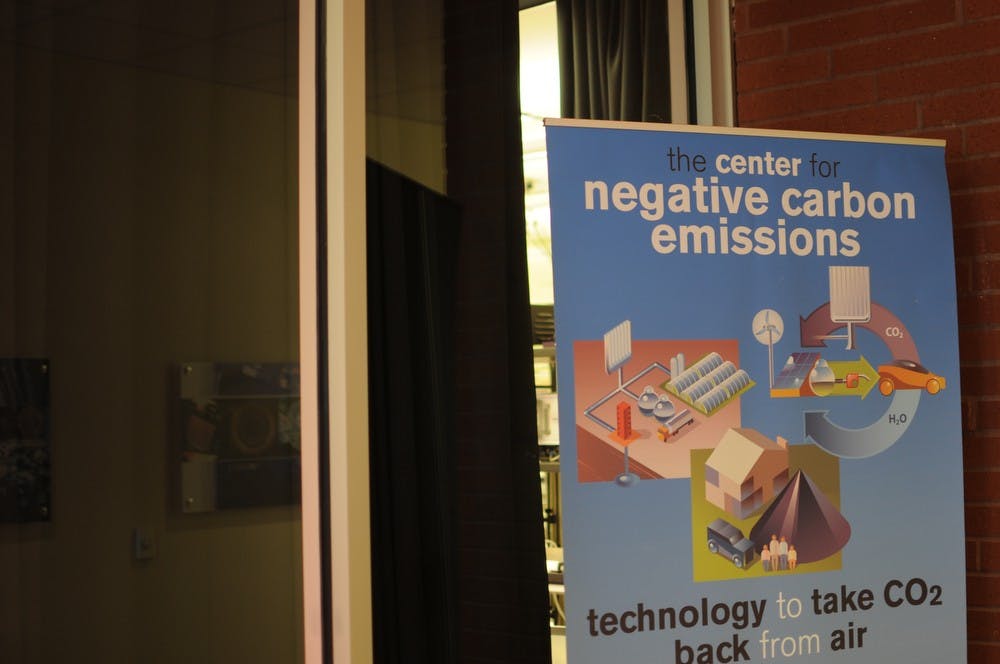To Klaus Lackner, the head professor at the Center for Negative Carbon Emissions in the Ira A. Fulton Schools of Engineering, managing the amount of carbon dioxide in the atmosphere is like balancing a budget — some must come in, some must go out, and to stay safe, there should be more incoming than outgoing.
Lackner said the center, which was formed last January, seeks to achieve negative carbon emissions, meaning that more CO2 will be disposed of rather than expelled into the atmosphere.
"Our goal is to develop means, technologies and, if necessary, policy structures that will allow us to balance the carbon budget over time," he said.
Let's tighten the carbon budget. Treat it like a waste. We can reduce, reuse and recycle the waste but we must remove it. #ActOnClimate
— Neg Carbon Emissions (@ASU_CNCE) November 20, 2015
Lackner said the current level of CO2 in the atmosphere is around 400 parts per million, within an upward trend of 2.2 more parts per million being added each year. If the level reaches 450 ppm, it is likely too late.
Lackner said this means humans have to do more than slow the rate of carbon emissions — they need to reverse it.
"We will need periods of what they call negative emissions, where humans take more CO2 back from the environment than they put in," he said. "It's the only way you can get a trajectory that keeps us on the safe side of climate change."
Lackner's group is not the first to confront this problem. Others have suggested using massive plant growth as a tool to reduce CO2, but Lackner said this likely isn't entirely feasible given the scale of the problem.
The center's main focus is air-capture technology, which essentially seeks to grab CO2 out of the air to dispose of it later.
"We have certain materials — it's a plastic — and it has a very high affinity for CO2 when dry, and the affinity drops dramatically when you make it wet," he said.
In other words, the material, known as an anionic exchange resin, takes CO2 out of the air when dry and releases it as a stream of CO2 enriched air when wet.
Lackner said the CO2 can then be reused in a variety of ways. The center, for example, is working with one group to feed the CO2 to algae so they can be used as fuel, or some greenhouses will buy it to help sustain their plants.
He said the implementation of these solutions will require support from governments and corporations. Convincing them to help will either take monetary incentives or simply the pain from a world with intolerably high levels of CO2.
However, the lab requires more than Lackner's contributions: It also needs someone to help transfer them into a physical reality. This is where Executive Director Allen Wright comes in.
"When we build something, I'm responsible for getting that thing built," he said. "It's a scaling exercise, starting with a small device, and getting it to work, going to a larger device and getting it to work, and so on."
He said the key to implementing carbon capture technologies, like the ones being developed at the center, is mass production of small units.
Yet Wright said the center is resource-limited, in that it cannot begin full production of its concepts until adequate funding comes in, and doing that is not always easy.
"I expect that some way to demonstrate that it's in the financial advantage of a company to participate in this technology would be useful," he said. "Whether that's the result of policy, law, subsidy ... it would probably result in a financial incentive for a company to get involved in this. If there's no way to make money doing it, it probably won't happen."
The center is also comprised of several doctoral students, all contributing several smaller projects to contribute to the broader goal.
For example, Hannah Rose Schonwald, an engineering graduate student with a background in geology, is working on a project to take the CO2 from the air and turn it into a stable mineral that can then be disposed of easily.
She said she is working on a proposal to create a system in which companies can buy the mineralized carbon as a sort of certificate to demonstrate their emissions and the reduction of the emissions.
The center has also been a key part in furthering Schonwald's education and career, as she wants to continue to pursue carbon management solutions after leaving.
"I've always been really interested in carbon management, but I always thought it would be a far off dream to get to be an expert in it and work right in the middle of the field," she said. "Working here on my Ph.D. can really help me with that dream."
Related Links:
ASU scientists develop carbon capture technology
University aiming to be carbon neutral by 2025
Reach the reporter at Arren.Kimbel-Sannit@asu.edu or follow @akimbelsannit on Twitter.
Like The State Press on Facebook and follow @statepress on Twitter.




